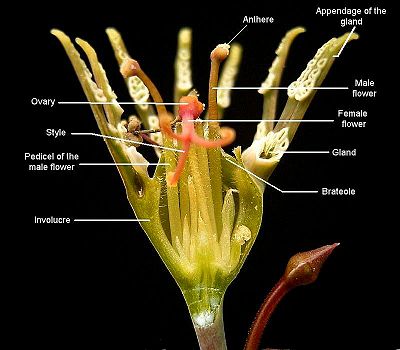- Cyathium
-
A cyathium (plural: cyathia) is one of the specialised pseudanthia ("false flowers") forming the inflorescence of plants in the genus Euphorbia (Euphorbiaceae). A cyathium consists of:
- Five (rarely four) bracteoles. These are small, united bracts, which form a cup-like involucre. Their upper tips are free and in the beginning cover the opening of the involucre (like the shutter of a camera). These alternate with:
- Five (1 to 10) nectar glands, which are sometimes fused.
- One extremely reduced female flower standing in the centre at the base of the involucre, consisting of an ovary on a short stem with pistil, and surrounded by:
- Five groups (one group at the base of each bracteole) of extremely reduced male flowers, which each consist of a single anther on a stem.
The flower-like characteristics of the cyathia are underlined by brightly coloured nectar glands and often by petal-like appendages to the nectar glands, or brightly coloured, petal-like bracts positioned under the cyathia. The paired petal-like bracts in the sub-family Euphorbia section Goniostema are called cyathophylls.
The cyathia are sometimes solitary, but are usually in cymes, inflorescences of the second order, in pseudumbels, on dichotomously branched stalks or in so-called simple cymes which consist of one central and two lateral cyathia.
In one group of Madagascan species in the sub-family Euphorbia section Goniostema (E. aueoviridiflora, E. capmanambatoensis, E. iharanae, E. leuconeura, E. neohumbertii, E. viguieri) there is a tendency for a further pseudanthium to grow from the cyme. Probably as an adaptation to pollination by birds, the cyathia have become specialised: Most cyathia have upright cyathophylles which surround them protectively, but render the nectar glands inaccessible. To compensate, between them are naked sterile cyathia whose only job is to produce nectar.
References
- (Italian) Sandro Pignatti, Flora d'Italia, Edagricole, Bologna 1982. ISBN 8850624492
Categories:
Wikimedia Foundation. 2010.

